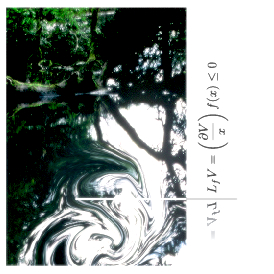
On the methodological side, interest is geared towards algebraic and differential-geometric methods for control design. Stabilization using motion planning and tracking is being developed. The jet-scheduling control method is an outcome of this research. It is a powerful and robust alternative to classical control design based on flatness.
A good deal of effort is also put in understanding and improving the domain of attraction of control laws. Particular care is taken in achieving as large an attraction domain as possible within physical limits (i.e. within realization constraints). This global issue has not yet been investigated sufficiently by the control community, although global stability, from a purely theoretical viewpoint, has been actively pursued.
In a similar direction, estimating and improving the attraction domain of classical control methodologies such as PD, PID control (in the nonlinear setting, that is, when applied to a nonlinear system such as a tokamak reactor) and nonlinear model predictive control, is also undertaken.
Understanding the de-stabilization effect of a control law is interesting, even though, in general, it is an opposite goal of a good control design done by engineers. One reason for this interest is that it could potentially explain how some pathologies appear in the human-coordination control system, such as in the case of shoulder arthritis.
The research group also investigates other global notions such as topological invariants of robot dynamics and kinematics. On this purpose, under-actuated, over-actuated and nonholonomic robots are considered both from a theoretical and a practical viewpoint.
Lecture
Introduction to the Analysis and Control of Nonlinear Systems
- Tokamak fusion reactors (partner: CRPP-EPFL).
- Adaptive optics (partners: MaxPlanck Institute Heidelberg, Geneva Observatory, ESO Gärching, LSRO-EPFL).
- Mechatronics (CV-VTT: partner LSRO-EPFL).
- Unmanned vehicles control (gliders and hydropters).
- Piezoelectric actuator control.
- Bio-mechanical feedback and control (shoulder articulation; partner LBO-EPFL, CHUV Lausanne).
- Robotics:
- Nonholonomic (individual vehicles and formation control).
- Under-actuated (crane control)
- Over-actuated (a specific class of redundant robots; adaptive optics).
- Various testbeds and small-scale setups, such as Toycopter and SpiderCrane, help in visualizing the theoretical methodologies and inspire new ideas and techniques.
Projects (past and ongoing) and PhD thesis
Tokamak Fusion Reactor Control
Goal: Improve the attraction domain of the tokamak controller.
Results: A complete characterization of the domain of attraction of 2-dimensional (2 states) linear systems with one stable and one unstable eigenvalue. There is a bifurcation in the type and shape of the attraction domain when the control and system parameters vary. The knowledge of the value at which the bifurcation appears helps improve the control design.
Application: Tokamak Control
Partner: CRPP-EPFL, J. Lister
Thesis: J.Y. Favez “Enhancing the control of tokamaks via a continuous nonlinear control law”, 2004. Control of Continuously Variable Transmissions
Goal: Modeling and control of continuously variable transmission power-trains.
Results:Input-output feedback linearization technique is applied to a suitable model obtained after theoretical model verification and experimental validation. Control performance is compared with classical controllers and improvements of the proposed controller are shown in various operating modes.
Application: Car variable transmission (i.e. gear-boxes without gears)
Thesis: R. Fuchs, “Dynamics of torque control continuously variable transmissions”, 2006 (done in collaboration with the LSRO-EPFL, Prof. H. Bleuler) Jet Scheduling for Flat Systems
Goal: Improve the robustness of flatness-based control with application to nonholonomic robots and crane control.
Results:The jet-scheduling methodology that separates the dynamics into two parts, one with small gains that allow gentle, yet swift, convergence to the equilibrium; another with large aggressive gains that help reject model mismatch such as dry friction appearing on the motor drives. Since it rests on differential flatness, it takes all nonlinear inertial forces into account to compensate for their negative effect on the convergence process.
Application: Crane control with real-time implementation on SpiderCrane.
Funding: FNRS 2100-068059
Thesis: D. Buccieri “Jet-scheduling for flat systems”, 2008. Over-actuated Robotics
Goal: To coordinate the control of many more actuators than really necessary to perform a given task, with an application to adaptive optics.
Results: Definition of coordination. Topological characterizations of simple robotical mechanism (small dimension). Techniques and proofs are given, for this class of systems, so as to achieve a periodic joint-motion coordination of a periodic output task, when the redundant manifold of configurations is not topologically simply connected. Coordination using actuators with complementary characteristics and limitations is also proposed.
Application: Control of a differential-delay line for the telescope used at the european southern observatory in Chile. Partners: ESO-Gärching, Geneva Observatory, Max-Planck-Institute für Astronomie Heidelberg,
Funding: FN FINES 206721-101 954 510.675 (PI at EPFL: Dr. Denis Gillet)
Thesis: Y. Michellod “Over-actuated Systems Coordination”, 2009. Algorithms for Lyapunov control and flat output determination
Goal: Find formal calculus methods for both constructing Lyapunov functions and finding flat outputs.
Results: Ongoing project.
Funding: FNRS 200021_119816/1
Thesis: B. Graf “Formal Methods for Lyapunov Based Controller Design and Flat Output Determination”, ongoing. Approximate feedback linearization of nonlinear systems
Goal: Find new methodologies for approximately linearizing a system through feedback and change of coordinates. The method uses quotient manifolds, that is, manifolds obtained after identifying trajectories as belonging to classes of equivalence. These equivalence classes then represent points of a new manifold of smaller dimension. In this way, a generalization of classical projection used in linear algebra are obtained. The controller is built from the resulting sequence of quotients manifolds by assigning the dynamics appearing within the representatives of the same class.
Results: Ongoing project.
Funding: FNRS 200031-117573/1
Thesis: S. Willson “Quotient Methods for Approximate Linearization”, ongoing. Could shoulder osteoarthritis be partly caused by a control feedback-law degeneracy ?
Goal: To assess to what extent control theoretical concepts can help understand the shoulder articulation and the pathology of arthritis that can appear in that articulation.
Results: ongoing
Funding: FNRS K-32K1_122512/1
Thesis: D. Ingram “Control of the Shoulder Articulation”, ongoing.